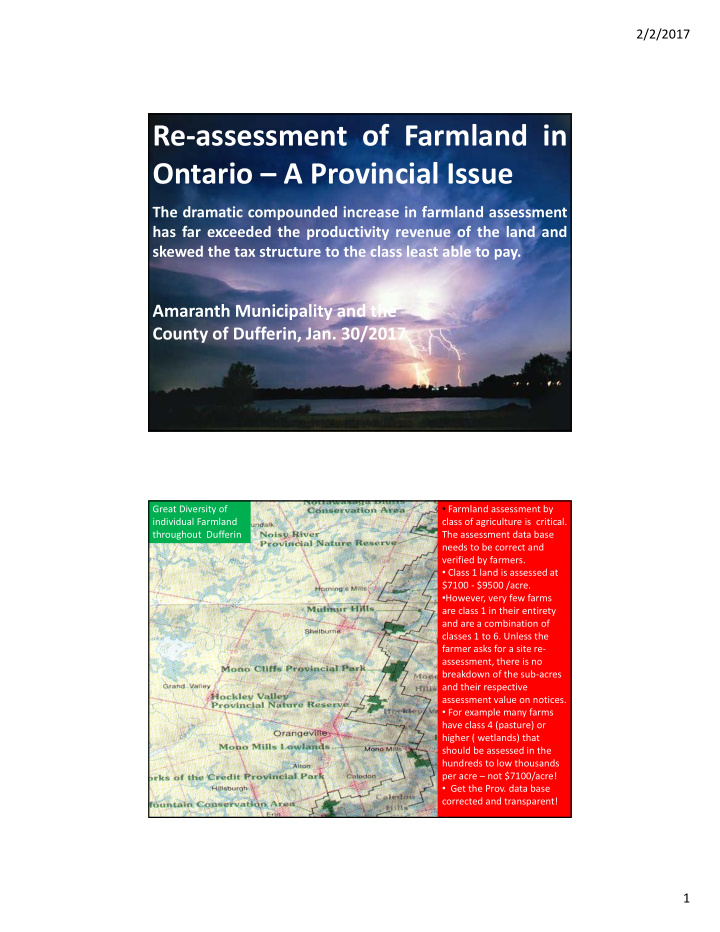



2/2/2017 Re‐assessment of Farmland in Ontario – A Provincial Issue The dramatic compounded increase in farmland assessment has far exceeded the productivity revenue of the land and skewed the tax structure to the class least able to pay. Amaranth Municipality and the County of Dufferin, Jan. 30/2017 • Farmland assessment by Great Diversity of individual Farmland class of agriculture is critical. throughout Dufferin The assessment data base needs to be correct and verified by farmers. • Class 1 land is assessed at $7100 ‐ $9500 /acre. • However, very few farms are class 1 in their entirety and are a combination of classes 1 to 6. Unless the farmer asks for a site re‐ assessment, there is no breakdown of the sub‐acres and their respective assessment value on notices. • For example many farms have class 4 (pasture) or higher ( wetlands) that should be assessed in the hundreds to low thousands per acre – not $7100/acre! • Get the Prov. data base corrected and transparent! 1
2/2/2017 • Historically, Dufferin farmers have developed, invested and protected farmland‐ it is their livelihood! • Protecting farmland and its sustainability is priority in both upper and lower tier Official Plans. Approximately half of Dufferin is managed by farmers with differing abilities to adapt to changing climates, social, economic and environmental changes 2
2/2/2017 Dufferin’s top five commodities are cattle, dairy, potatoes, soybeans and corn with over $120M in cash receipts in 2012 with value of $270M through related purchases such as machinery sales, repair, parts and wages/farm labour. Dramatic increase in farmland assessments by MPAC • Ontario’s farmland values are increasing by a whopping average of 80% over the next four years. (source: MPAC) • This new rise in farmland values compounded with the 65% increase in 2012‐2016 assessment values have alarmed farmers . • Farmland property values increased at a greater rate than any other property classification in Ontario. • Farms have a 2 tax level assessment. One for the farm house /one acre and one for the farmland. • Farmland does not require many of the municipal services compared to the farm house or urban dwellings (eg. Sewers) 3
2/2/2017 CHANGING FARMLAND • Dufferin’s loss of farmland was 11% between the 2006 and 2011 census. • Similar to other losses in the Province, Dufferin lost 41‐60% of their farmland between 1951 to 2001 • On top of these land base losses, farmers are experiencing significant increases in input costs along with substantial declines in commodity prices. • Hence an unsustainable business that needs Provincial protection. • There is no possible way farmland can grow the value of products to match the increase in farmland assessments. HIGHER INFRASTRUCTURE COSTS • Funding of many support services are based on the assessment totals of the Municipalities. • Applications for Infrastructure Grants demonstrates that we have above average incomes, above average assessments and we are not in debt compared to the Province – hence we are turned down for 2/3 funding support. • The rapid increase in farmland assessments have artificially skewed the tax structure by failing to evaluate the difference between total assessed farmland value and 25% tax revenue paid to the Municipalities. As a result, infrastructure costs have far exceeded the Municipalities ability to afford replacement bridges and roads leading to bridge and road closures. • Re‐evaluation of the input criteria and rankings for rural Municipalities is urgently needed. 4
2/2/2017 The dramatic compounded increase in farmland assessment has far exceeded the productivity revenue of the land and skewed the tax structure to the class least able to pay. 5
Recommend
More recommend